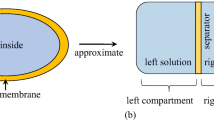Abstract
According to standard membrane theory, the generation of membrane potential is attributed to transmembrane ion transport. However, there have been a number of reports of membrane behavior in conflict with the membrane theory of cellular potential. Putting aside the membrane theory, we scrutinized the generation mechanism of membrane potential from the view of the long-dismissed adsorption theory of Ling. Ling’s adsorption theory attributes the membrane potential generation to mobile ion adsorption. Although Ling’s adsorption theory conflicts with the broadly accepted membrane theory, we found that it well reproduces experimentally observed membrane potential behavior. Our theoretical analysis finds that the potential formula based on the GHK eq., which is a fundamental concept of membrane theory, coincides with the potential formula based on Ling’s adsorption theory. Reinterpreting the permeability coefficient in the GHK eq. as the association constant between the mobile ion and adsorption site, the GHK eq. turns into the potential formula from Ling’s adsorption theory. We conclude that the membrane potential is generated by ion adsorption as Ling’s adsorption theory states and that the membrane theory of cellular potential should be amended even if not discarded.





Similar content being viewed by others
References
Boström M, Lima ERA, Biscaia EC Jr, Tavares FW, Nostro PL, Parsons DF, Deniz V, Ninham BW (2009) Anion-specific partitioning in two-phase finite volume systems: possible implications for mechanisms of ion pumps. J Phys Chem B 113:8124
Chang D (1977) A physical model of nerve axon—I. Ionic distribution, potential profile, and resting potential. Bull Math Biol 39:1
Chang D (1983) Dependence of cellular potential on ionic concentrations. Data supporting a modification of the constant field equation. Biophys J 43:149
Clay JR (2009) Determining K+ channel activation curves from K+ channel currents often requires the Goldman–Hodgkin–Katz equation. Front Cell Neurosci 3:1
Clay JR, Shrier A (2001) Action potentials occur spontaneously in squid giant axons with moderately alkaline intracellular pH. Biol Bull 201:186
Clay JR, Paydarfar D, Forger DB (2008) A simple modification of the Hodgkin and Huxley equations explains type 3 excitability in squid giant axons. J R Soc Interface 5:1421
Colacicco G (1965a) Electrical potential at an oil/water interface. Nature 207:936
Colacicco G (1965b) Reversal of potential across a liquid non-aqueous membrane with regard to membrane excitability. Nature 207:1045
Cronin J (1987) Mathematical aspects of Hodgkin–Huxley neural theory. Cambridge University Press, New York
Einstein A (1902) On the thermodinamic theory of the difference in potentials between metals and fully dissociated solutions of their salts and on an electrical method for investigating molecular forces. Annalen der Physik 8:798
Ermentrout GB, Terman DH (2010) Mathematical foundations of neuroscience. Springer, New York
Lagi M, Nostro PL, Fratini E, Ninham BW, Baglioni P (2007) Insights into Hofmeister mechanisms: anion and degassing effects on the cloud point of dioctanoylphosphatidylcholine/water systems. J Phys Chem B 111:589
Ling GN (1992) A revolution in the physiology of the living cell. Krieger, Malabar, FL
Ling GN (2011) Truth in basic biomedical science will set future mankind free. Physiol Chem Phys Med NMR 41:19
Mentré P (2006) Saibou no naka no mizu (Japanese translation) (Water in the cell). University of Tokyo Press, Tokyo
Ninham BW, Duignan TT, Parsons DF (2011) Approaches to hydration, old and new: insights through Hofmeister effects. Curr Opin Colloid Interface Sci 16:612
Ninham BW, Larsson K, Nostro PL (2017) Two sides of the coin. Part 1. Lipid and surfactant self-assembly revisited. Colloids Surf B Biointerface 152:326
Nostro PL, Peruzzi N, Severi M, Ninham BW, Baglioni P (2010) Asymmetric partitioning of anions in lysozyme dispersions. J Am Chem Soc 132:6571
Olschewski A, Olschewski H, Bräu ME, Hempelmann G, Vogel W, Safronov BV, Respir J (2001) Basic electrical properties of in situ endothelial cells of small pulmonary arteries during postnatal development. Cell Mol Biol 25:285
Pollack GH (2001) Cells, gels and the engines of life. Ebner & Sons, Seattle
Pollack GH (2013) The fourth phase of water: beyond solid, liquid, and vapor. Ebner & Sons, Seattle
Pollack GH (2015) Cell electrical properties: reconsidering the origin of the electrical potential. Cell Biol Int 39:237
Tamagawa H, Morita S (2014) Membrane potential generated by ion adsorption. Membranes 4:257
Tamagawa H, Ikeda K (2017) Generation of membrane potential beyond the conceptual range of Donnan theory and Goldman–Hodgkin–Katz equation. J Biol Phys 43:319
Tamagawa H, Funatani M, Ikeda K (2016) Ling’s adsorption theory as a mechanism of membrane potential generation observed in both living and nonliving systems. Membranes 6:11
Temsamani KR, Cheng KL (2001) Studies of chloride adsorption on the Ag/AgCl electrode. Sens Actuators B Chem 76:551
Uteshev VV (2010) Evaluation of Ca2+ permeability of nicotinic acetylcholine receptors in hypothalamic histaminergic neurons. Acta Biochim Biophys Sin 42:8
Wnek GE (2016) Perspective: Do macromolecules play a role in the mechanisms of nerve stimulation and nervous transmission? J Poly Sci 54:7
Wright EM, Diamond JM (1968) Effects of pH and polyvalent cations on the selective permeability of gall-bladder epithelium to monovalent ions. Biochim Biophys Acta 1635:57
Acknowledgements
This work was carried out under the financial support by Koshiyama Science and Technology Foundation.
Author information
Authors and Affiliations
Corresponding author
Rights and permissions
About this article
Cite this article
Tamagawa, H., Ikeda, K. Another interpretation of the Goldman–Hodgkin–Katz equation based on Ling’s adsorption theory. Eur Biophys J 47, 869–879 (2018). https://doi.org/10.1007/s00249-018-1332-0
Received:
Revised:
Accepted:
Published:
Issue Date:
DOI: https://doi.org/10.1007/s00249-018-1332-0




